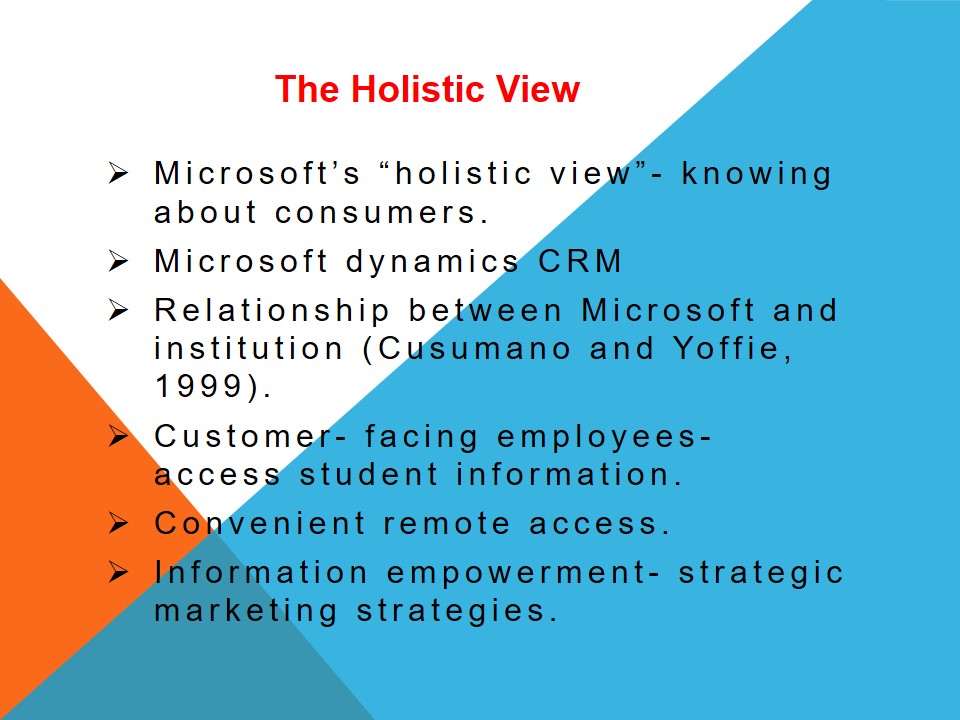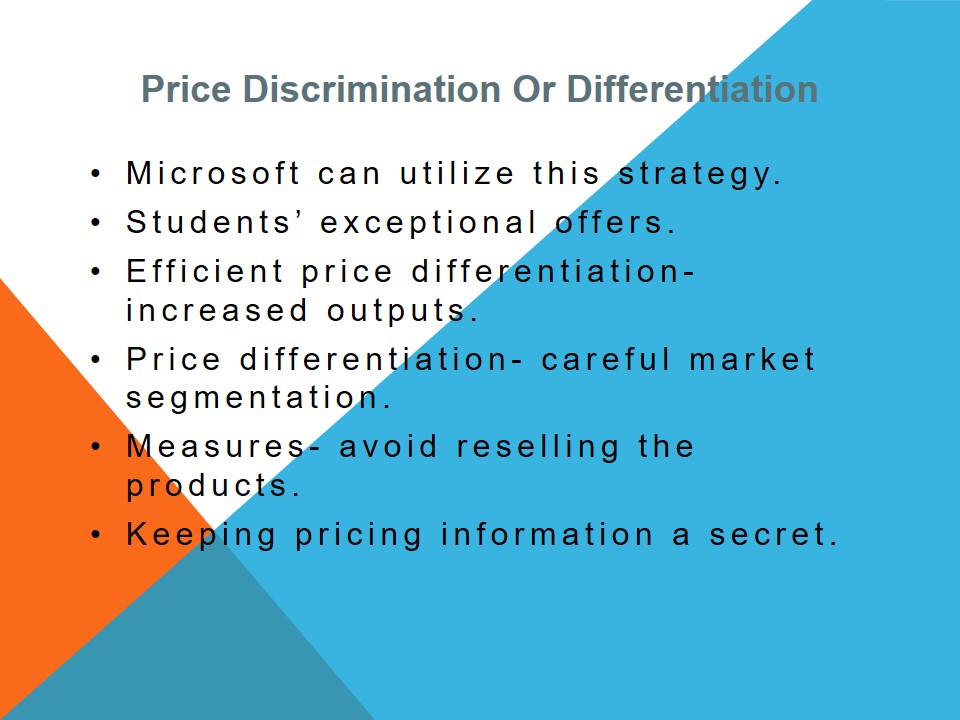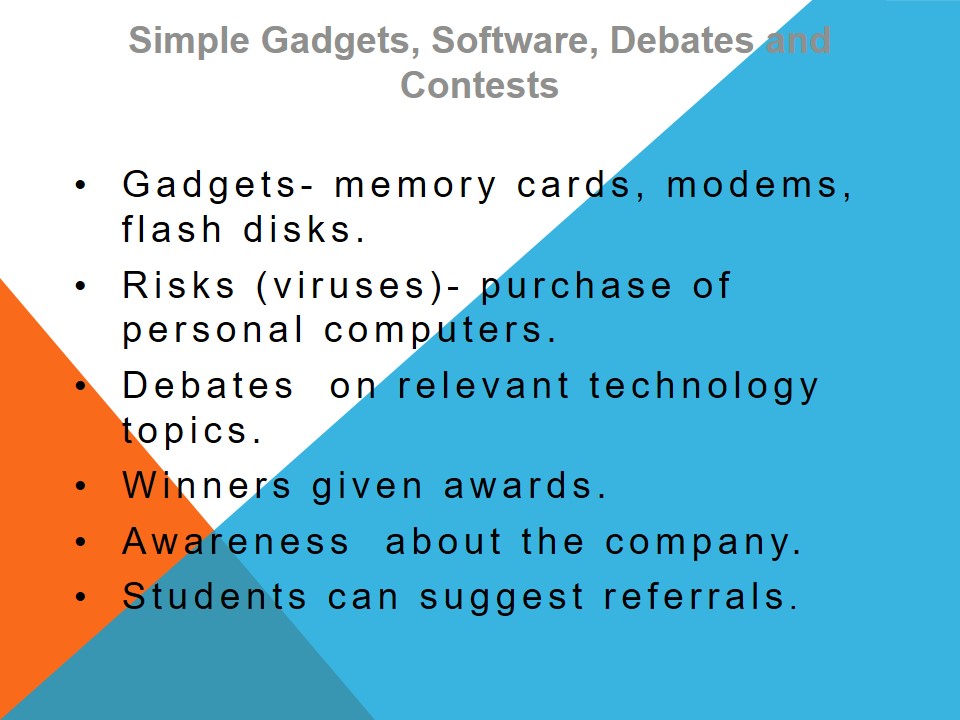The Holistic View
- Microsoft’s “holistic view”- knowing about consumers.
- Microsoft dynamics CRM.
- Relationship between Microsoft and institution (Cusumano and Yoffie, 1999).
- Customer- facing employees- access student information.
- Convenient remote access.
- Information empowerment- strategic marketing strategies.
Microsoft should use the holistic view so as to comprehend students’ needs and the most appropriate relationships to initiate. Customer- facing employees should be ready to seek information from students. This will ensure that Microsoft applies the best marketing strategies.

Price Discrimination Or Differentiation
- Microsoft can utilize this strategy.
- Students’ exceptional offers.
- Efficient price differentiation- increased outputs.
- Price differentiation- careful market segmentation.
- Measures- avoid reselling the products.
- Keeping pricing information a secret.
- Pricing at development stage (Bontis, 1998: 70).
- Systematic pricing measures and policies.
- Larger profits, defend the market share.
- Effective pricing strategies- achieving strategic goals.
- Significance of keen planning.
- Assessment of customers’ needs.
Price differentiation or discrimination is an extremely effective strategy that Microsoft can use to increase sales among students. For effective price differentiation, the market should be segmented appropriately. In addition, measures should be put in place to ensure that students do not resell the products at a discount.
Microsoft should price their products during development. This pricing strategy ensures that products and services promote profitable prices. The company should consider the strategic goals before formulating their prices.


Simple Gadgets, Software, Debates and Contests
- Gadgets- memory cards, modems, flash disks.
- Risks (viruses)- purchase of personal computers.
- Debates on relevant technology topics.
- Winners given awards.
- Awareness about the company.
- Students can suggest referrals.
Through the sale of simple and affordable software and gadgets, Microsoft can arouse interest in students. To use the software and gadgets, a student requires a personal computer. This might lead to the purchase of a personal computer to avoid risks such as viruses.
The company can also organize debates on relevant technologies. The winners can be awarded prizes such as personal computers and software.

Video Games
- Video games stimulates the brain (Hellofs and Jacobson, 1999: 17).
- Adaptations and creative solutions.
- Thoughts and ideas- real life circumstances.
- The society and people- creative and positive.
- Video games industry.
- Increased product sales.
Microsoft can create innovative and creative video games that students can use. Consequently, these video games can be advertised and sold in universities and colleges. The use of such video games requires other products that can be obtained from the company.

Recruitment and Employments Strategies
- Training, education, recruitment, and employment (Klein, 2001: 20).
- Success- immense knowledge about the company.
- Recruitment strategies- various skills and knowledge.
- Increase the market share among students.
Microsoft can engage in a wide array of recruitment, employment, education, and training strategies. Success in such programs depends on possessing immense knowledge about the company. Through these strategies, the company can acquire a greater market share.

References
Bontis, N 1998, “Intellectual Capital: An Exploratory Study That Develops Measures and Models”, Management Decision, vol. 36 iss. 2, pp. 63-76.
Cusumano, MA & Yoffie, DB 1999, Competing On Internet Time: Lessons From Netscape And Its Battle With Microsoft, Free Press, New York.
Hellofs, Ll & Jacobson, R 1999, “Market Share And Customers’ Perceptions Of Quality: When Can Firms Grow Their Way To Higher Versus Lower Quality?”, The Journal Of Marketing, vol. 3 iss. 2, pp. 16- 25.
Klein, B 2001, “The Microsoft Case: What Can A Dominant Firm Do To Defend Its Market Position?”, The Journal Of Economic Perspectives, vol.15 iss. 2, pp. 12-32.